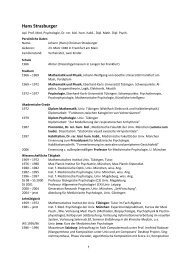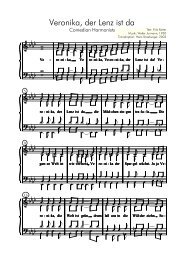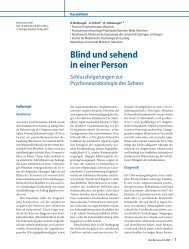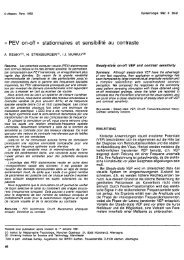Peripheral vision and pattern recognition: a review - strasburger - main
Peripheral vision and pattern recognition: a review - strasburger - main
Peripheral vision and pattern recognition: a review - strasburger - main
You also want an ePaper? Increase the reach of your titles
YUMPU automatically turns print PDFs into web optimized ePapers that Google loves.
<strong>Peripheral</strong>_Vision.doc<br />
Concerning the physiological substrate underlying the psychophysical measurements,<br />
Wertheim (1894) <strong>and</strong> Fick (1898) related them to the density of retinal receptor cells. Excellent<br />
data on retinal cone <strong>and</strong> rod receptor densities were provided by Østerberg (1935) (Figure 4;<br />
note the detail with which these measurements were taken) <strong>and</strong> still underlie many current<br />
textbook figures. Polyak (1932) went one step further <strong>and</strong> concluded from his anatomical<br />
studies that there must be a mathematical function which describes the retino-cortical mapping.<br />
Talbot <strong>and</strong> Marshall (1941) studied this in the central part of the visual field <strong>and</strong> derived a<br />
projection factor that could be expressed by a single number. Yet acuity data <strong>and</strong> receptor<br />
densities re<strong>main</strong>ed in the center of interest (e.g. Pirenne, 1962). Weymouth (1958) concluded<br />
that receptor densities cannot underlie many of the decline functions from his extensive<br />
overview of acuity <strong>and</strong> other spatial visual performance measures (Figure 5), as well as of the<br />
neurophysiological literature. Instead he proposed retinal ganglion cells as the possible<br />
neurophysiological substrate (cf. Curcio & Allen, 1990).<br />
Figure 4. Cone <strong>and</strong> rod receptor density results by<br />
Østerberg (1935). These data underlie many of the<br />
current textbook figures.<br />
Figure 5. MAR functions <strong>review</strong>ed by<br />
Weymouth (1958). “Comparison of vernier<br />
threshold, minimal angle of resolution,<br />
motion threshold, <strong>and</strong> mean variation of the<br />
settings of horopter rods” (1958, Fig. 13)<br />
For decades acuities had been plotted on the ordinate of a typical graph – i.e., the inverse of a<br />
spatial threshold – but Weymouth advocated going back to showing the spatial thresholds<br />
directly. He called the latter “minimum angle of resolution” (MAR), a term still used today.<br />
Daniel <strong>and</strong> Whitteridge (1961) <strong>and</strong> Cowey <strong>and</strong> Rolls (1974) were next to study the relationship<br />
between the retinal <strong>and</strong> the primary cortical mapping, a str<strong>and</strong> of research that had started with<br />
10






